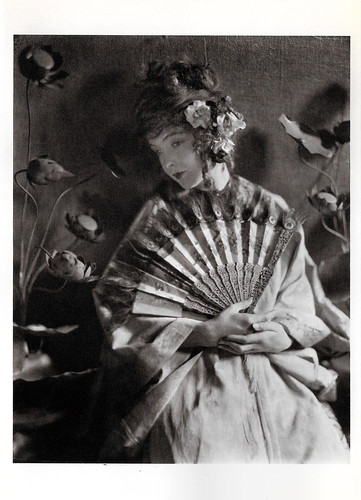
American postcard by Fotofolio, NY, NY, no. JA13. Photo: James Abbe. Lillian Gish in Broken Blossoms (David Wark Griffith, 1919).
American actress Lillian Gish (1893-1993) was 'The First Lady of the Silent Screen'. During the 1910s, she was one of director D.W. Griffith's greatest stars. She appeared in his features such as The Birth of a Nation (1915), Broken Blossoms (1919), and Orphans of the Storm (1921). After 13 years with Griffith, she moved to MGM where her first picture was La Bohème (King Vidor, 1926). In the 1940s, after a long interval, she returned to the screen in a handful of films and received a Best Supporting Actress Oscar nomination for her role as Laura Belle McCanles in Duel in the Sun (King Vidor, 1946). Again a decade later, she was marvellous in the classic Film Noir The Night of the Hunter (Charles Laughton, 1955). Her last film was The Whales of August (Lindsay Anderson, 1987) in which she shared the lead with Bette Davis.
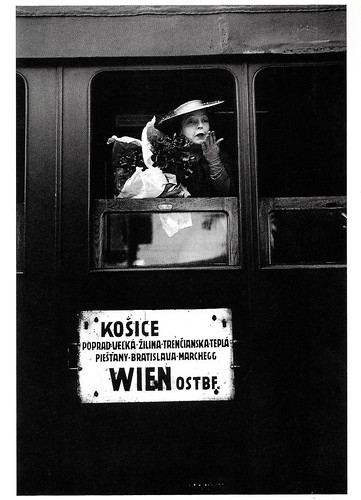
Swiss postcard by News Productions, Baulmes, no. 55706. Photo: John Phillips / Musée de l'Elysée, Lausanne. Caption: Actress and inveterate Traveller Lillian Gish blows a goodbye kiss to friends in Czechoslovakia as she leaves for the USA in 1938, shortly before Hitler occupies Prague.

American postcard by Fotofolio, NY, NY, no. JA2. Photo: James Abbe, 1921. Rudolph Valentino and Natascha Rambova.
Rudolph Valentino (1895-1926) was Hollywood's ultimate 'Latin Lover'. The Italian-born American actor starred in several well-known silent films including The Four Horsemen of the Apocalypse (1921), The Sheik (1922), Blood and Sand (1922), The Eagle (1925), and The Son of the Sheik (1926). His early death at age 31 caused mass hysteria among his female fans and propelled him into iconic status.
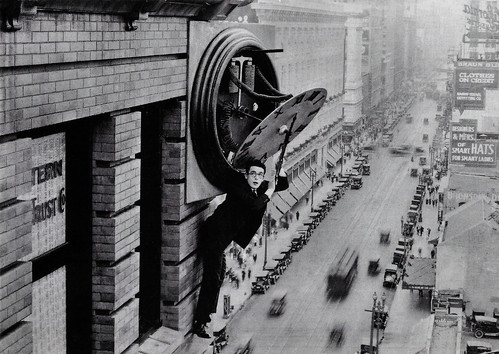
American postcard by The Museum of Modern Art, New York, N.Y., no. 9260, 1988. Photo: The Museum of Modern Art / Film Stills Archive. Harold Lloyd in Safety Last (Fred C. Newmeyer, Sam Taylor, 1923).
American actor, comedian, director, producer, screenwriter, and stunt performer Harold Lloyd (1893-1971) is best known for his silent comedies. He ranks alongside Charlie Chaplin and Buster Keaton as one of the three most popular and influential comedians of silent film. Between 1914 and 1947, Lloyd made nearly 200 comedies, often as a bespectacled 'Glass' character, a resourceful, success-seeking go-getter who was perfectly in tune with the 1920s-era United States. His films frequently contained 'thrill sequences' of extended chase scenes and daredevil physical feats. A classic is Lloyd hanging from the hands of a clock high above the street in Safety Last! (1923).
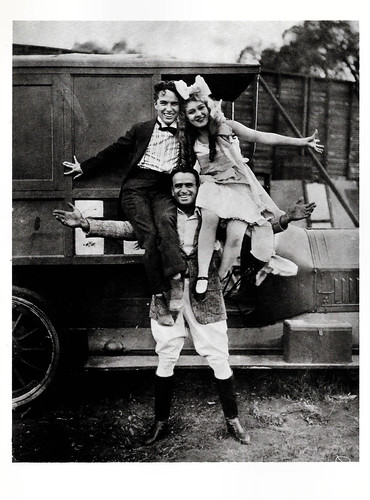
American postcard by Fotofolio, NY, NY, no. P51. Photo: Culver Pictures. Charlie Chaplin, Mary Pickford and Douglas Fairbanks, Hollywood, 1917.
English comedian Charles ‘Charlie’ Chaplin (1889-1977) was one of the most creative and influential personalities of the silent-film era. His most famous role was that of The Tramp with his toothbrush moustache, undersized bowler hat and bamboo cane who struggled to survive while keeping his dignity in a world with great social injustice. Chaplin used mime, slapstick and other visual comedy routines, and he not only starred in his films, but also directed, wrote and produced them, and composed the music as well. His working life in entertainment spanned over 75 years, from the Victorian stage and the Music Hall in the United Kingdom as a child performer, until close to his death at the age of 88. Author George Bernard Shaw called Chaplin "the only genius to come out of the movie industry".
Mary Pickford (1892-1972) was a legendary silent film actress and was known as 'America’s sweetheart.' She was a founder of United Artists and helped establish the Academy.
American actor Douglas Fairbanks (1883-1939) was best known for his swashbuckling roles in silent films such as The Mark of Zorro (1920), Robin Hood (1922), and The Thief of Bagdad (1924), but spent the early part of his career making comedies. Fairbanks was a founding member of United Artists and of The Motion Picture Academy. He hosted the first Oscars Ceremony in 1929. With his marriage to Mary Pickford in 1920, the couple became Hollywood royalty, and Fairbanks was referred to as The King of Hollywood'', but his career rapidly declined with the advent of the 'talkies. His final film was made in Great Britain, The Private Life of Don Juan (1934).

Vintage postcard, no. F4. Charlie Chaplin in The Gold Rush (Charles Chaplin, 1925).
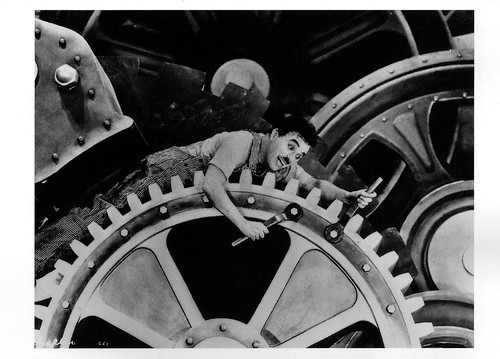
American postcard by Pomegranate Publications, Petaluma, no. 2063. Charlie Chaplin in Modern Times (Charles Chaplin, 1936).

American postcard by The Museum of Modern Art, New York, N.Y., no. 9255, 1988. Photo: The Museum of Modern Art / Film Stills Archive. Buster Keaton in The Frozen North (Edward F. Cline, Buster Keaton, 1922).
Stone-faced Buster Keaton (1895-1966) was one of the three greatest comedians of Silent Hollywood.
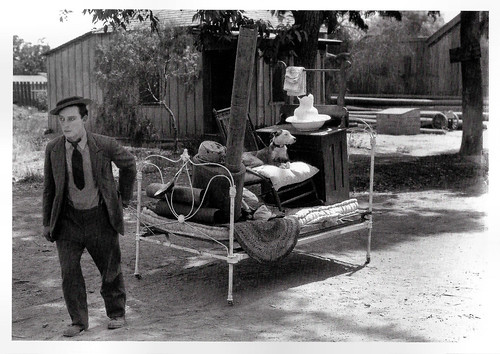
British postcard by Portfolio, London, no. VO 18. Photo: Kobal Collection. Buster Keaton in Go West (Buster Keaton, 1925).

American postcard by The Museum of Modern Art, New York, N.Y., no. 9266, 1982. Photo: The Museum of Modern Art / Film Stills Archive. Buster Keaton in The General (Clyde Bruckman, Buster Keaton, 1927).

British postcard by World Postcards Inc., no. X283, 1990, no. 9266, 1982. Buster Keaton in The General (Clyde Bruckman, Buster Keaton, 1927).
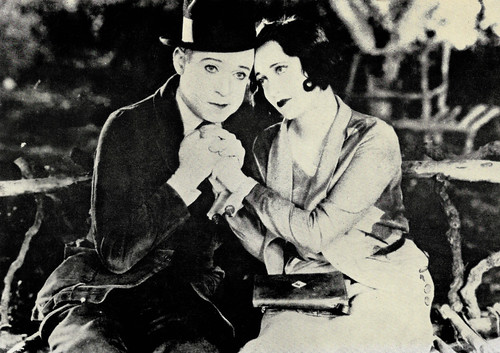
French postcard by François Nugeron, Paris. Photo: Collection Snark. Harry Langdon and Joan Crawford in Tramp, Tramp, Tramp (Frank Capra, 1926). The French film title was Plein des bottes.
Hollywood comedian Harry Langdon (1884-1944), often called 'Baby Face', had enormous success during his heyday. Early in his film career, he had the good fortune to work regularly with director Harry Edwards, writer Frank Arthur Ripley, and the young Frank Capra. They created his unique character of the innocent and helpless man-child who found himself in dramatic and hazardous circumstances with only providence and good luck to survive. Despite his success, Langdon has remained far more obscure than his contemporaries as Charlie Chaplin, Harold Lloyd, and Buster Keaton.
American film star Joan Crawford (1904-1977) had a career that would span many decades, studios, and controversies. In her silent films, she made an impact as a vivacious Jazz Age flapper and later she matured into a star of psychological melodramas.
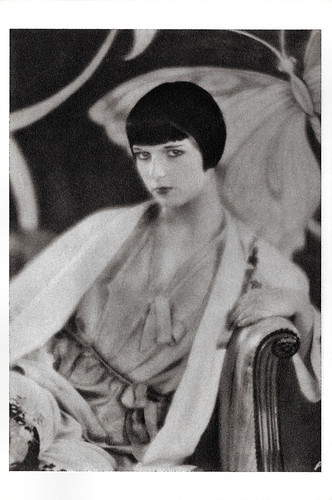
French postcard by Editions La Malibran, Paris, no. CA 30. Photo: Eugene Robert Richee.
Legendary American dancer and actress Louise Brooks (1906-1985) set the trend of the bobbed haircut and personified the flapper, the rebellious young woman of the 1920s. She played the lead in three European silent film classics: Die Büchse der Pandora/Pandora's Box (1929), Tagebuch einer Verlorenen/Diary of a Lost Girl (1929), and Prix de Beauté /Miss Europe (1930).
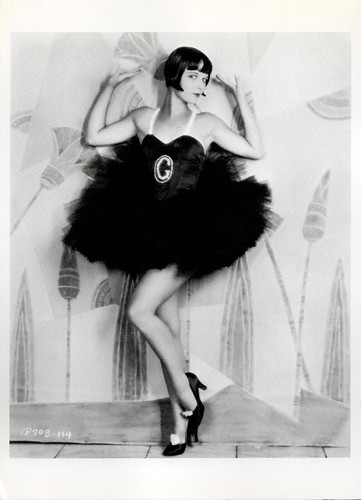
American postcard by Fotofolio, NY, NY, no. K 45. Photo: Eugene Robert Richee / The Kobal Collection. Caption: Louise Brooks, 1928.

American postcard by Fotofolio, NY, NY, no. GH8. Photo: George Hurrell / Creative Art Images, Hollywood. Caption: Ramon Novarro, 1931. Publicity still for Daybreak (Jacques Feyder, 1931).
Mexican-American actor Ramon Novarro (1899-1968) was a popular Latin Lover of the 1920s and early 1930s. He was the star of silent Hollywood's biggest epic, Ben-Hur (Fred Niblo, 1925).
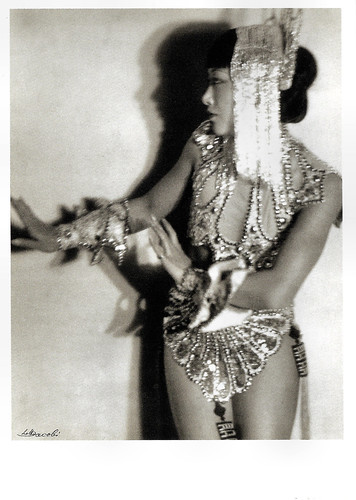
German postcard in the Ausdrucktstanz series by Galerie Bodo Niemann, Berlin, no. 08/10. Photo: Lotte Jacobi. Caption: Anna May Wong, Berlin, ca. 1931.
Anna May Wong (1905-1961) was the first Chinese-American movie star, and the first Asian American actress to gain international recognition. Frustrated by the stereotypical supporting roles she reluctantly played in Hollywood, Wong left for Europe, where she starred in such classics as Piccadilly (1929).
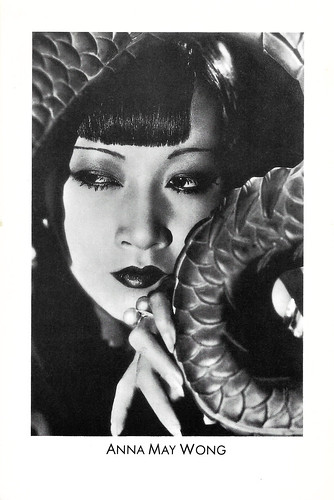
British postcard by James Gardiner Postcards, Watford in The Glamour Queens series, no. 15, 1988. Photo: Otto Dyar.
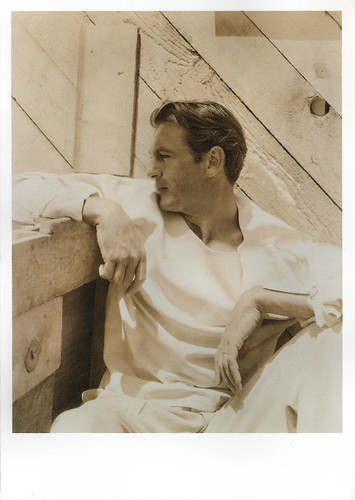
American postcard by the Metropolitan Museum of Modern Art, no. 01-02619-3, 1994. Photo: George Hoyningen-Huene. Caption: Gary Cooper, 1934.
American screen legend Gary Cooper (1901-1961) is well remembered for his stoic, understated acting style in more than one hundred Westerns, comedies and dramas. He received five Oscar nominations and won twice for his roles as Alvin York in Sergeant York (1941) and as Will Kane in High Noon (1952).

British postcard by Camden Graphics Ltd, London, 1982, no. PC 427. Photo: Cecil Beaton. Caption: Marlon Brando, 1946.
American film star Marlon Brando (1924-2004) was one of the greatest and most influential actors of all time. A cultural icon, Brando is most famous for his Oscar-winning performances as Terry Malloy in On the Waterfront (Elia Kazan, 1954) and Vito Corleone in The Godfather (1972). He initially gained popularity for recreating the role of Stanley Kowalski in the film A Streetcar Named Desire (Elia Kazan,1951), adapted from the Tennessee Williams play in which he became recognized as a Broadway star during its 1947–49 stage run. Then followed his Academy Award-winning performance as Terry Malloy in On the Waterfront (Elia Kazan, 1954), as well as for his iconic portrayal of the rebel motorcycle gang leader Johnny Strabler in The Wild One (Laslo Benedek, 1953), which is considered to be one of the most famous images in pop culture.
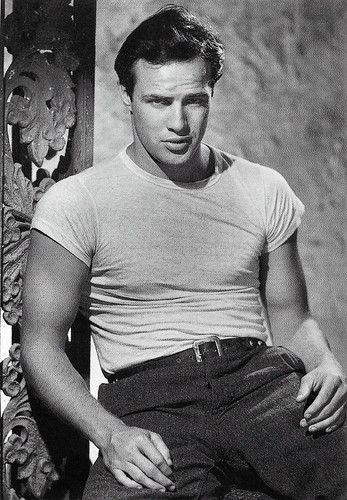
French postcard by Editions La Malibran, Paris, no. CA 74. Photo: John Engstead. Marlon Brando in A Streetcar Named Desire (Elia Kazan, 1951).
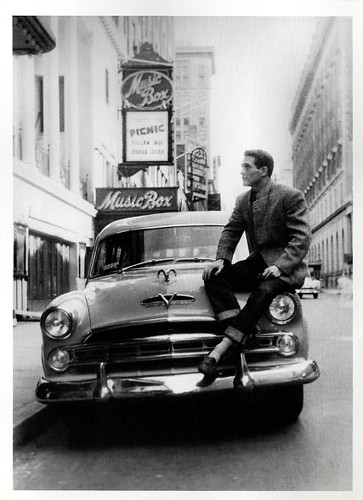
American postcard by Fotofolio, NY, NY, no. P332. Photo: D. D. & E. Peter Schroeder. Caption: Paul Newman, New York City, 1953.
American film actor Paul Newman (1925-2008) was a matinee idol with the most famous blue eyes in Hollywood, who often played detached yet charismatic anti-heroes and rebels. He was nominated for nine acting Academy Awards in five different decades and won the Oscar for The Color of Money (1986). He was also a prominent social activist, a major proponent of actors' creative rights, and a noted philanthropist.
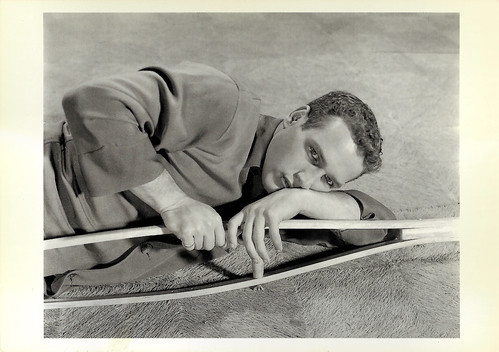
French postcard in the Collection Magie Noire by Editions Hazan, Paris, 1988, no. 6015. Photo: anonymous / Ciné Images.
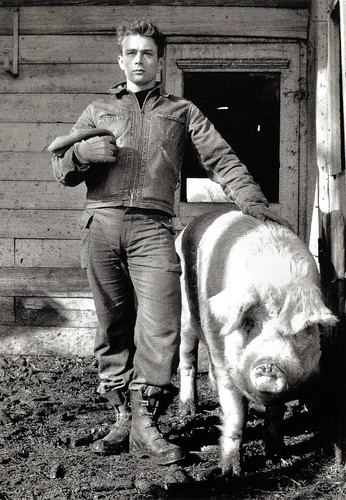
French postcard by Grafique de France, no. SC 109. Photo: Dennis Stock. Caption: James Dean, 1954.
American actor James Dean (1931-1955) was the quintessential 1950s teenager, brooding and romantic. An air of androgyny attributed to his iconic appeal to both men and women. The three roles that defined his stardom are as troubled teenager Jim Stark in Rebel Without a Cause (1955), loner Cal Trask in East of Eden (1955) and surly Ranch hand Jett Rink in Giant (1956). After his death in a car crash, the only 24-year-old Dean became the first actor to receive a posthumous Academy Award nomination for Best Actor.

American postcard by Pomegranate Publications, Rohnert Park, CSA, no. 2925. Photo: Roy Schatt.
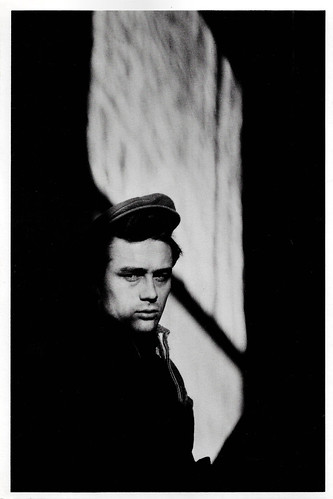
American postcard by the American Postcard Co., no. 250, 1984. Photo: Dennis Stock. Caption: James Dean, Fairmount, Indiana, 1955.
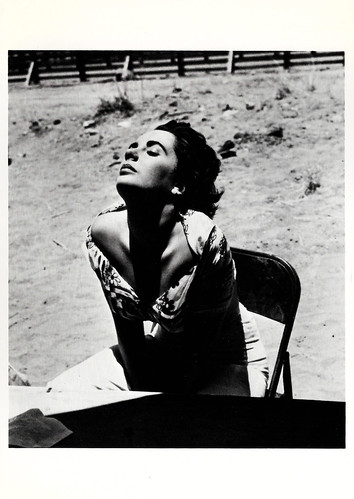
American postcard by Fotofolio, NY, NY, no. P145. Photo: Sid Avery. Elizabeth Taylor sunning herself on the Marfa, Texas set of Giant, 1955.
British-American actress Elizabeth Taylor (1932-2011) began as a child star. As an adult, she came to be known for her acting talent and beauty. She had a much-publicised private life, including eight marriages and several near-death experiences. Taylor was considered one of the great actresses of Hollywood's Golden Age.
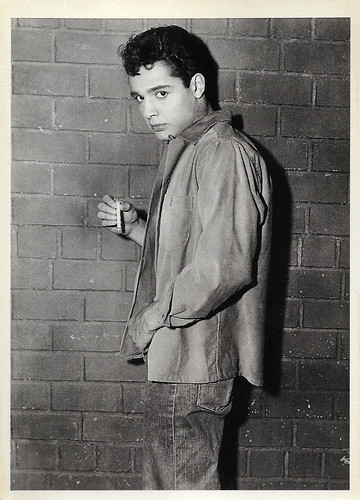
American postcard by Pomegranate Publications, Petaluma, CA, no. 5874. Photo: Michael Ochs Archives.
American actor Sal Mineo (1939-1976) was a teen idol during the late 1950s. He shot to fame as Plato in the classic Rebel Without a Cause (1955) featuring James Dean. Diminutive and sad-eyed, his performance perfectly captured the film's themes of youthful desperation, and struck a chord with audiences as well as critics, earning him a Best Supporting Actor Academy Award nomination. He co-starred again with Dean in Giant (1956) and with Paul Newman in Somebody Up There Likes Me (1956). In 1957, he scored a pair of Top 40 hits with 'Start Movin' (In My Direction) and 'Lasting Love'.

American postcard by Fotofolio, NY, NY, no. MP3. Photo: Eve Arnold / Magnum Photos Inc. Caption: Marilyn Monroe, Studio Session, Hollywood, 1960.
No comments:
Post a Comment